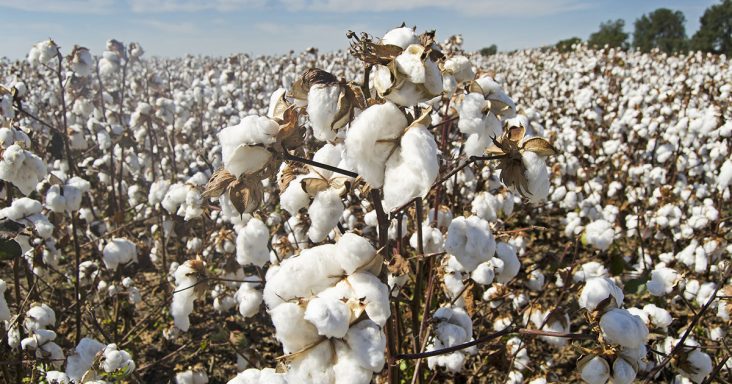Cotton crop yields up, acres down in 2020
by December 29, 2020 4:17 pm 1,849 views

Cotton, along with other Arkansas row crops, got off to a slow start when the planting season began in 2020. Torrential rains stymied farmers’ efforts along with the impacts from the unfolding COVID-19 pandemic.
Despite the slow start, Arkansas cotton farmers had somewhat of a comeback year. Yields approached or exceeded a record-breaking 1,200 pounds per acre, according to the United States Department of Agriculture National Agricultural Statistics Service. It was about 10 pounds above 2019 yields. Prices were better than expected as harvests began even though the state got hit with two hurricanes during the period.
Farmers harvested 490,000 cotton acres, a drop of about 120,000 acres. It looked like it could have ended much worse in mid-May.
“By May 18, only 47% of the crop had been planted,” Scott Stiles, extension economist for the University of Arkansas System Division of Agriculture, said. “Another way to say this is: half the crop was planted past the optimal cut-off date.”
Planting progress continued to lag behind the five-year average almost until mid-June. By mid-season, cotton crop metrics improved.
“In August we had the potential for a great crop statewide,” Bill Robertson, extension cotton agronomist for the Division of Agriculture, said. “The August National Agricultural Statistics Service estimated 1,200 pounds of lint per acre and represented a new all-time high. We likely could have been on track for better than 1,300 pounds.”
Some of those projections were dashed by powerful storms. Throughout the 2020 hurricane season, the Atlantic Basin churned out a record number of named storms. The remnants of Hurricane Laura arrived in Arkansas at the end of August and more rain followed.
“Total September and October rainfall at Marianna was 10.44 inches,” Stiles said. “That delayed harvest and reduced yield and quality.”
Both Stiles and Robertson said delayed planting and frequent rain in October pushed a third of this year’s harvest into November.
“Tropical Storm Delta moved in the state Oct. 10. After that, a pattern of rain every three to four days set in for the balance of the month,” Stiles said.
The constant rain caused “harvest delays during our prime picking windows, which hurt us with direct yield and quality losses but extended our harvest period well past our target completion date of Nov. 1,” Robertson said, adding that he finished his variety plot harvest Nov. 23.
The rain and wind caused quality loss in the cotton lint in terms of color and leaf content. Stiles said the quality difference alone in the 2019 and 2020 crops is $23 to $24 per acre, assuming the average 1,200-pound-per-acre yield.
Rain wasn’t the only problem cotton growers faced. Weeds and insects were a problem for producers all season.
“Pigweed and plant bugs are our big pests,” Robertson said. “The loss of effectiveness of two-gene Bt varieties, especially in south Arkansas for worm management, are a big concern. New three-gene Bt varieties with very good yield potentials will be commercially available in 2021 and bring some relief from worms.”
Bt cotton is engineered to resist bollworms.
“Weed control, especially Palmer pigweed, is our big thorn in our side,” he said. “With our current tools in Arkansas, weed control was not cheap or easy in 2020.”
He said that most growers “have plans for 2021 well in motion and hope these results can help with transition from two-gene Bt varieties to the new three-gene Bt varieties.”
The pandemic impacted virtually all parts of agriculture economic sectors and cotton was not immune. COVID-19 travel restrictions caused either delays or cancellations in getting foreign workers to the United States.
“Many operations in the Delta are using the H-2A guest worker program to source employees from Mexico, Romania and South Africa,” Stiles said. “This may be an issue again in spring 2021.”
As the pandemic sent the workforce home, clothing sales plummeted, rippling backward into the textile supply.
“A slowdown in economic activity and consumer spending as a result of COVID-19 took cotton prices sharply lower throughout the first quarter of 2020,” Stiles said. And while analysts debated whether an economic recovery would be “L-shaped,” “U-shaped” or “V-shaped,” cotton went with the letter V.
“Cotton started the year with a high of 73 cents in January, then crashed down to an 11-year low of 50.18 cents in early April,” Stiles said. “And then almost made it back to the January high by Oct. 28 — peaking at 72.60.”
“The likely explanation behind cotton’s price recovery is something less related to pure supply/demand fundamentals and more related to speculative money flows,” he said. “An influx of speculative/managed money took up ‘long’ or ‘buy’ positions in the cotton market at the exact time it was trading at 11-year lows.”
Arkansas cotton producers did get help from the government, as of Dec. 13, receiving $18.1 million from the second round of the Coronavirus Food Assistance Program. That amount is likely to climb since the deadline for growers to sign up for this second round was Dec. 11.
